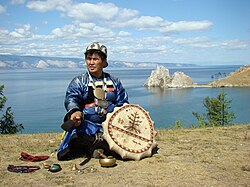Shamanism

Shamanism is a practice where a practitioner reaches altered states of consciousness. Supposedly, the shaman perceives and interacts with a spirit world, and channels these energies into this world.[1]
A shaman is a person regarded as having access to, and influence in, the world of good and bad spirits. They usually enter into a trance state during a ritual, and do divination and healing.[2] To become a shaman, a person has to have had a near death experience (a "shamanic illness").[3]
The name "shaman" comes from the Evenki people in Siberia.[3]
Shamans play a central role in these movements, as they can be in both worlds, this one, and the world of spirits.
Beliefs
- Spirits are real and can do things in the real world.
- There are good and evil spirits.
- Healing can be done in the spirit and real world.
- A person's spirit can leave their body and go into the world of the spirits.
- Animal shapes are used to interact with the spirits.
Shamanism is different from animism.
Films
- Quantum Men (Carlos Serrano Azcona) Spain 2011
- Other Worlds (Jan Kounen) France 2004
- Bells From the Deep (Werner Herzog) Germany 1993
- The Mad Masters (Jean Rouch) France 1955
- Au pays des mages noirs (Jean Rouch) France 1947
Shamanism Media
The earliest known depiction of a Siberian shaman, by the Dutch explorer Nicolaes Witsen, 17th century. Witsen called him a "priest of the Devil" and drew clawed feet for the supposed demonic qualities.[5]
Bonda "disari" (shaman) Sukra Dhangdamajhi shares his shamanic practices in the Bonda language
South Moluccan shaman in an exorcism ritual involving children, Buru, Indonesia (1920)
Buryat shaman on Olkhon Island, Russia
References
- ↑ Hoppál, Mihály 2007. Is shamanism a folk religion?. Shamans and Traditions, vol 13. Bibliotheca Shamanistica. Budapest: Akadémiai Kiadó. ISBN 978-963-05-8521-7
- ↑ Oxford Dictionary Online[dead link].
- ↑ 3.0 3.1 Stern, David. "Shamans: Masters of Ecstasy". National Geographic. Archived from the original on 17 March 2016. Retrieved 25 February 2016.
- ↑ Hoppál 2005, pp. 77, 287.
- ↑ Hutton 2001, p. 32.





